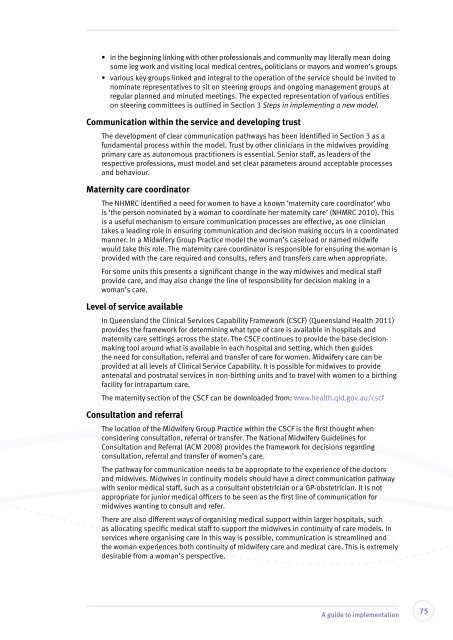Delivering continuity of midwifery care to Queensland women
Delivering continuity of midwifery care to Queensland women
Delivering continuity of midwifery care to Queensland women
You also want an ePaper? Increase the reach of your titles
YUMPU automatically turns print PDFs into web optimized ePapers that Google loves.
• in the beginning linking with other pr<strong>of</strong>essionals and community may literally mean doing<br />
some leg work and visiting local medical centres, politicians or mayors and <strong>women</strong>’s groups<br />
• various key groups linked and integral <strong>to</strong> the operation <strong>of</strong> the service should be invited <strong>to</strong><br />
nominate representatives <strong>to</strong> sit on steering groups and ongoing management groups at<br />
regular planned and minuted meetings. The expected representation <strong>of</strong> various entities<br />
on steering committees is outlined in Section 3 Steps in implementing a new model.<br />
Communication within the service and developing trust<br />
The development <strong>of</strong> clear communication pathways has been identified in Section 3 as a<br />
fundamental process within the model. Trust by other clinicians in the midwives providing<br />
primary <strong>care</strong> as au<strong>to</strong>nomous practitioners is essential. Senior staff, as leaders <strong>of</strong> the<br />
respective pr<strong>of</strong>essions, must model and set clear parameters around acceptable processes<br />
and behaviour.<br />
Maternity <strong>care</strong> coordina<strong>to</strong>r<br />
The NHMRC identified a need for <strong>women</strong> <strong>to</strong> have a known ‘maternity <strong>care</strong> coordina<strong>to</strong>r’ who<br />
is ‘the person nominated by a woman <strong>to</strong> coordinate her maternity <strong>care</strong>’ (NHMRC 2010). This<br />
is a useful mechanism <strong>to</strong> ensure communication processes are effective, as one clinician<br />
takes a leading role in ensuring communication and decision making occurs in a coordinated<br />
manner. In a Midwifery Group Practice model the woman’s caseload or named midwife<br />
would take this role. The maternity <strong>care</strong> coordina<strong>to</strong>r is responsible for ensuring the woman is<br />
provided with the <strong>care</strong> required and consults, refers and transfers <strong>care</strong> when appropriate.<br />
For some units this presents a significant change in the way midwives and medical staff<br />
provide <strong>care</strong>, and may also change the line <strong>of</strong> responsibility for decision making in a<br />
woman’s <strong>care</strong>.<br />
Level <strong>of</strong> service available<br />
In <strong>Queensland</strong> the Clinical Services Capability Framework (CSCF) (<strong>Queensland</strong> Health 2011)<br />
provides the framework for determining what type <strong>of</strong> <strong>care</strong> is available in hospitals and<br />
maternity <strong>care</strong> settings across the state. The CSCF continues <strong>to</strong> provide the base decisionmaking<br />
<strong>to</strong>ol around what is available in each hospital and setting, which then guides<br />
the need for consultation, referral and transfer <strong>of</strong> <strong>care</strong> for <strong>women</strong>. Midwifery <strong>care</strong> can be<br />
provided at all levels <strong>of</strong> Clinical Service Capability. It is possible for midwives <strong>to</strong> provide<br />
antenatal and postnatal services in non-birthing units and <strong>to</strong> travel with <strong>women</strong> <strong>to</strong> a birthing<br />
facility for intrapartum <strong>care</strong>.<br />
The maternity section <strong>of</strong> the CSCF can be downloaded from: www.health.qld.gov.au/cscf<br />
Consultation and referral<br />
The location <strong>of</strong> the Midwifery Group Practice within the CSCF is the first thought when<br />
considering consultation, referral or transfer. The National Midwifery Guidelines for<br />
Consultation and Referral (ACM 2008) provides the framework for decisions regarding<br />
consultation, referral and transfer <strong>of</strong> <strong>women</strong>’s <strong>care</strong>.<br />
The pathway for communication needs <strong>to</strong> be appropriate <strong>to</strong> the experience <strong>of</strong> the doc<strong>to</strong>rs<br />
and midwives. Midwives in <strong>continuity</strong> models should have a direct communication pathway<br />
with senior medical staff, such as a consultant obstetrician or a GP-obstetrician. It is not<br />
appropriate for junior medical <strong>of</strong>ficers <strong>to</strong> be seen as the first line <strong>of</strong> communication for<br />
midwives wanting <strong>to</strong> consult and refer.<br />
There are also different ways <strong>of</strong> organising medical support within larger hospitals, such<br />
as allocating specific medical staff <strong>to</strong> support the midwives in <strong>continuity</strong> <strong>of</strong> <strong>care</strong> models. In<br />
services where organising <strong>care</strong> in this way is possible, communication is streamlined and<br />
the woman experiences both <strong>continuity</strong> <strong>of</strong> <strong>midwifery</strong> <strong>care</strong> and medical <strong>care</strong>. This is extremely<br />
desirable from a woman’s perspective.<br />
A guide <strong>to</strong> implementation<br />
75
















